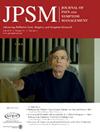生命终结时脱机加热高流量鼻插管
IF 3.5
2区 医学
Q2 CLINICAL NEUROLOGY
引用次数: 0
摘要
Outcomes1。热高流量鼻插管接近生命末期时,识别和处理常见症状。制定策略,为临终时使用热高流量鼻插管的患者制定具有文化能力的以患者为中心的跨学科护理计划。在生命末期选择停用加热高流量鼻插管的患者通常需要对包括呼吸困难和焦虑在内的痛苦症状进行强化管理。我们将回顾在生命结束时逐步脱机加热高流量鼻插管的方法,包括症状管理和实施文化上称职的以患者为中心的跨学科护理计划。摘要:抽离式高流量鼻插管(HHFNC)允许患者接受高水平的氧支持,同时仍然能够保持互动(1)。然而,一些患者的肺功能没有恢复到足以离开急性护理环境,可能会选择退出氧支持。在这种情况下,断奶HHFNC和控制症状的最佳做法尚未得到很好的研究(2)。方法我们对在三级医疗中心断奶HHFNC的44例死亡患者进行了单中心回顾性图表回顾。所有纳入的患者在2021年1月至2024年5月期间接受了住院姑息治疗团队的护理。本研究的主要目的是确定HHFNC断奶期间使用的阿片类药物和苯二氮卓类药物的中位剂量。收集基线特征、断奶48小时内最大hfnc设置(流量和吸氧分数)、断奶前两天阿片类药物和苯二氮卓类药物的使用情况、断奶开始和终止时间,以及用于预防和治疗升级性呼吸困难和焦虑的症状管理药物的累积量。结果选择在临终时停用hfnc的患者通常需要对包括呼吸困难和焦虑在内的痛苦症状进行强化管理。我们假设逐步断奶HHFNC的患者比没有断奶的HHFNC患者有更好的症状控制。我们将分享我们逐步断奶HHFNC的方法,以及在HHFNC断奶期间使用的阿片类药物和苯二氮卓类药物的中位剂量。结论选择在生命末期断奶HHFNC的患者通常需要对痛苦症状进行强化管理。我们预测,一个循序渐进的方法来断奶加热高流量鼻插管和实施一个文化上称职的以患者为中心的跨学科护理计划是确保高质量护理的基础。史波莱蒂尼G,阿洛泰比M,布拉西F,希尔NS。成人加热加湿高流量鼻吸氧。胸科。2015年7月1日;148(1):253-61。2. 金美良,李彦杰,朴景生,等。在准备脱离高流量鼻插管氧治疗的患者中,同时减少流量和吸入氧(FiO2)与先减少流量或先减少FiO2:随机对照试验的研究方案(SLOWH试验)。审判。2020年12月;21:1-7。本文章由计算机程序翻译,如有差异,请以英文原文为准。
Weaning Heated High Flow Nasal Cannula at End of Life
Outcomes
1. Identify and manage common symptoms when patients on heated high flow nasal cannula approach end of life.
2. Develop strategies to create a culturally competent patient-centered interdisciplinary care plan for patients on heated high flow nasal cannula at end of life.
Key Message
Patients who elect to wean heated high flow nasal cannula at end of life often require intensive management of distressing symptoms including dyspnea and anxiety. We will review a stepwise approach to weaning heated high flow nasal cannula at end of life, including symptom management and implementation of culturally competent patient-centered interdisciplinary care plan.
Abstract
Heated high flow nasal cannula (HHFNC) allows patients to receive a high level of oxygen support while still being able to remain interactive (1). However, some patients don't recover enough lung function to leave an acute care setting and may elect withdrawal of oxygen support. Best practices for weaning HHFNC and managing symptoms in this setting have not been well studied (2).
Methods
We conducted a single-center retrospective chart review on 44 deceased patients who were weaned from HHFNC at a tertiary care medical center. All patients included received care by the inpatient palliative care team between January 2021 and May 2024. The primary objective of this study was to determine the median dosage of opioids and benzodiazepines used during HHFNC wean. Baseline characteristics, maximum HHFNC settings (flow rate and fraction of inspired oxygen) within 48 hours of the wean, opioid and benzodiazepine usage in the two days prior to the wean, time of wean initiation and termination, and cumulative amount of symptom management medications used to prevent and treat escalating dyspnea and anxiety were collected.
Results
Patients who elect to wean HHFNC at end-of-life often require intensive management of distressing symptoms including dyspnea and anxiety. We hypothesize that patients who have HHFNC weaned in a stepwise manner experience better symptom control than patients who have HHFNC stopped without a wean. We will share our stepwise approach to weaning HHFNC and the median doses of opioid and benzodiazepine medications used during HHFNC wean.
Conclusion
Patients who elect to wean HHFNC at end of life often require intensive management of distressing symptoms. We predict that a stepwise approach to weaning heated high flow nasal cannula and implementation of a culturally competent patient-centered interdisciplinary care plan are fundamental to ensuring high quality care.
References
1. Spoletini G, Alotaibi M, Blasi F, Hill NS. Heated humidified high-flow nasal oxygen in adults. Chest. 2015 Jul 1;148(1):253-61. 2. Kim MC, Lee YJ, Park JS, et al. Simultaneous reduction of flow and fraction of inspired oxygen (FiO2) versus reduction of flow first or FiO2 first in patients ready to be weaned from high-flow nasal cannula oxygen therapy: study protocol for a randomized controlled trial (SLOWH trial). Trials. 2020 Dec;21:1-7.
求助全文
通过发布文献求助,成功后即可免费获取论文全文。
去求助
来源期刊
CiteScore
8.90
自引率
6.40%
发文量
821
审稿时长
26 days
期刊介绍:
The Journal of Pain and Symptom Management is an internationally respected, peer-reviewed journal and serves an interdisciplinary audience of professionals by providing a forum for the publication of the latest clinical research and best practices related to the relief of illness burden among patients afflicted with serious or life-threatening illness.

 求助内容:
求助内容: 应助结果提醒方式:
应助结果提醒方式:


